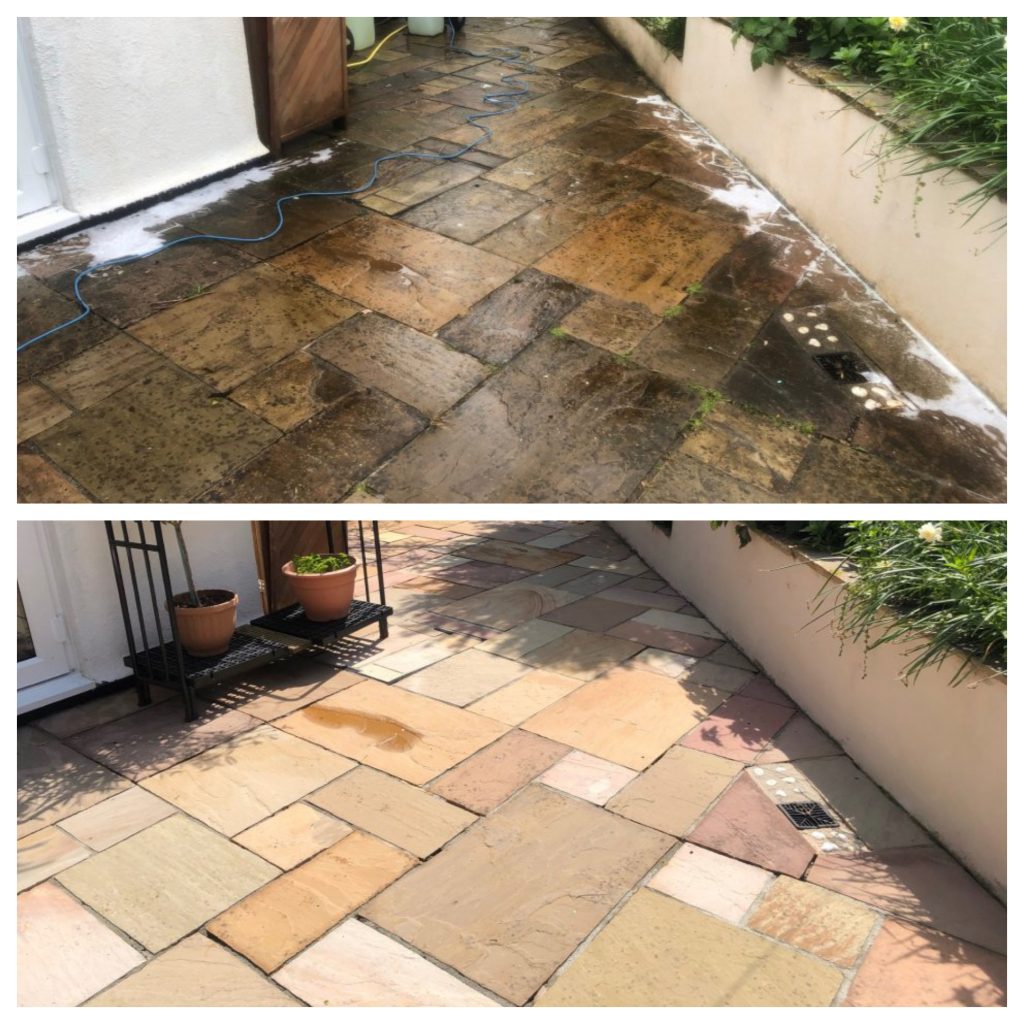Pressure washing a patio seems like an easy task, not much different to washing a car, right?
Well, to some extent, yes.
But the reality is, there are a lot of things to plan for so you don’t get caught up spending hours on something you thought wouldn’t take much of your time. Let’s be honest, we all have better things to do in our free time than pressure washing a patio or a driveway.

To clean a patio, you will need a pressure washer, a patio cleaning solution, and some protective gear.
The first thing to do is to identify the type of surface you are going to be cleaning and if it is suitable to use a pressure washer.
Is the Surface Safe to Pressure Wash?
Some of the surfaces you need to pay particular attention to are listed below:
- Delicate surfaces: Certain materials, such as delicate brick, natural stone, or render, can be easily damaged by the high pressure of a pressure washer.
- Softwoods: Pressure washing can strip away the protective layers of softwoods such as cedar or redwood, leaving the wood exposed to rot and decay.
- Asbestos: Pressure washing asbestos can release asbestos fibers into the air, which can be harmful if inhaled.
- Paint: If the paint is already peeling or chipping, pressure washing can cause the paint to come off in large pieces.
- Loose or damaged mortar: Pressure washing can dislodge loose or damaged mortar, causing further damage to your surfaces.
- Decks and fences made of treated lumber: Treated lumber is often pressure treated with chemicals that can be harmful if released into the environment. Pressure washing these surfaces can strip away the protective layer and release the chemicals into the air or water.
- Roofs: Pressure washing a roof can be dangerous and can also damage shingles, tiles, or other roofing materials.
- Landscaping: Plants, flowers, and shrubs can be damaged or killed by the high pressure of a pressure washer.
- Windows: High pressure water can damage window seals and frames, leading to water damage and leaks.
It is important to be cautious when pressure washing and to take the necessary precautions to avoid damaging your surfaces and the environment. If in doubt, it’s best to consult a professional to avoid potential harm and to ensure the job is done correctly.

15 Tips on How to Pressure Wash Your Patio
- Buy a cleaning solution suitable for your type of floor
- Clear the patio of any furniture or debris, and sweep it clean.
- Put on protective gear: boots, gloves, safety glasses, long trousers and hearing protection.
- Mix the patio cleaning solution according to the manufacturer’s instructions.
- Turn on the pressure washer and begin cleaning the patio, starting at the farthest corner and working your way towards the exit. Use a wide, sweeping motion and overlap your passes to ensure that the entire surface is cleaned.
- Once the patio is clean, turn off the pressure washer and rinse the patio with a garden hose to remove any remaining cleaning solution.
- Allow the patio to dry completely before replacing any furniture or walking on it.
- When using the pressure washer, be sure to keep a safe distance from the surface you’re cleaning. Holding the nozzle too close can cause damage to the patio and can also be dangerous.
- Use a low pressure nozzle for delicate surfaces such as natural stones, bricks or wood decking.
- Use a high pressure nozzle for tough stains or built up dirt.
- Once you have completed the pressure washing, inspect the patio for any missed stains or areas that may need a second cleaning.
- Lastly, ensure you store the pressure washer and the cleaning solution properly and dispose of any waste water responsibly to protect the environment.
- Regular maintenance of the patio can help to prevent the build-up of dirt and grime. Clean up spills and stains immediately and consider applying a sealer to protect the surface.
- If you are not comfortable using a pressure washer, consider hiring a professional to do the job for you. This can be especially helpful if your patio is large, or if you have delicate surfaces that need special attention.
It’s also a good idea to test the cleaning solution on a small, inconspicuous area of the patio before using it on the entire surface to make sure it doesn’t cause any damage.

Finally, be mindful of the weather conditions when pressure washing your patio. It’s best to avoid pressure washing in direct sunlight, as the cleaning solution can dry too quickly and leave streaks, and also avoid pressure washing in the rain as it may not be effective and can be dangerous.
By following these steps, you can effectively pressure wash a patio and keep it looking clean and refreshed for a while. Another benefit is keeping everyone safe, removing algae and mold off the surfaces, especially with the weather in the UK
As you can see, there are a lot of details to remember and if you don’t approach this carefully, it can be a costly attempt. Chances are, the first time you pressure wash a patio, driveway or anything around your property, the results won’t look as good as if you had someone experienced doing it. Like everything else in life.
It’s important to be cautious when pressure washing and to take the necessary precautions to avoid damaging your surfaces and the environment. If in doubt, it’s best to consult a professional to avoid potential harm and to ensure the job is done correctly.
Here at MB Exterior Cleaning, we offer a range of services that can save time and money, without risk to your property. We will get the job done safely and effectively so you don’t have to worry about it. Plus, we use commercial heavy duty machinery combined with stronger products to leave your patio or driveway spotless.
If you would like to get a quote, click here and fill out the form. We will be in touch ASAP.

